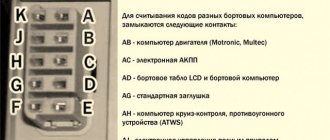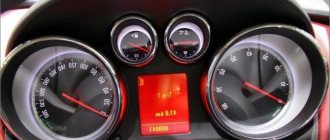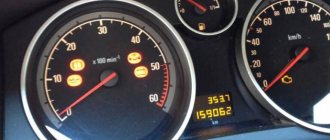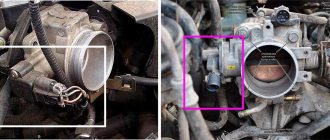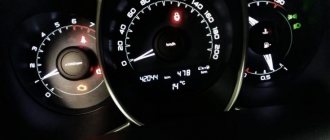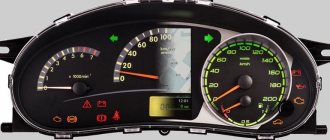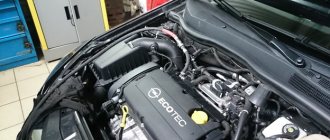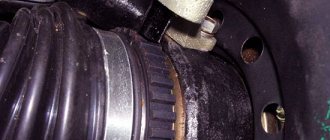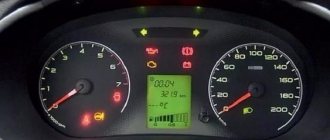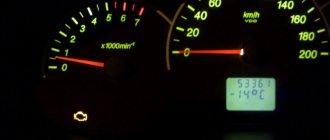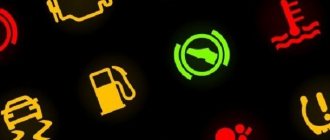We received an Opel Insignia for diagnostics. Driver complaint - CHECK ENGINE light came on. At the same time, the engine runs smoothly and the car drives normally. We connect the device - it displays error P0328 “Knock sensor high voltage.”
By analogy with Skoda, we can assume that we are talking about a broken wiring, but, as it turns out, the problem is different.
The first thought is that the knock sensor itself is faulty. But where does the high voltage come from then? The manual suggests checking the volts on both wires of the sensor connector.
There should be 1-2 V and 2.5-3.5 V, respectively, when the ignition is on. This is clear, but where is the knock sensor itself installed?
And here is the answer: on the back side of the cylinder block, between the starter and the generator!
Let's start measuring the voltage. We try to unfasten the connector from above, but in the process we understand: “someone has already been here!” The wiring harness is not secured, it is just dangling in the air. This is an excellent reason to ask the client, because it is obvious that something was done to the car before it was delivered to our service center.
High-quality diagnostics are the key to peace of mind
The client turned out to be a cheerful woman; she told the story of the car repair, which was more like a heartbreaking thriller. It started with CHECK ENGINE blinking while driving. During diagnostics in a neighboring garage, the would-be master “sentenced” the spark plugs. The counter is running - original candles, minus 2000 rubles. from the wallet.
After replacing the spark plugs, the alarm icon on the panel did not go out, and the engine continued to operate intermittently. The car was taken to a more advanced service center, where the “specialists” found a problem in the ignition module. The owner buys the original spare part again. Minus 5000 rub. But the problem does not go away.
Long research led the craftsmen to the idea that the engine needed to be rebuilt. Allegedly, the piston may burn out. This is not uncommon for Opel turbo engines. But before us is an ordinary aspirated engine with a volume of 1.8 liters. The mileage on the odometer is only 20,000 km. Piston burnout? Hard to believe. But the engine was still rebuilt - for 50,000 rubles.
The engine started running smoothly, but the ominous CHECK ENGINE icon did not go out.
As a result of in-depth diagnostics, it was concluded that it would be a good idea to change the knock sensor - they say, the error clearly indicates a malfunction in this circuit. The original knock sensor costs 3,000 rubles. Please note that all amounts are approximate and DO NOT take into account the cost of diagnostics.
From the fact that the car was brought to us, we can guess that replacing the knock sensor did not help. After such an exciting story, we could not remain indifferent and agreed on another standard hour for diagnostics.
directional stability icon is on
ModeratorCOLON Ekspluat
directional stability icon is on
Post by Ruslan56 » Sat Dec 17, 2011 16:45
Re: Stability control icon is on
Posted by eaurougemagic » Sat Dec 17, 2011 6:40 pm
Opel Astra F(1993) C18NZ automatic transmission
If you hit the headlight very, very hard, you can break the fuel pump. and a couple more details. (WITH)
Re: Stability control icon is on
Posted by eaurougemagic » Sat Dec 17, 2011 6:46 pm
Opel Astra F(1993) C18NZ automatic transmission
If you hit the headlight very, very hard, you can break the fuel pump. and a couple more details. (WITH)
Re: Stability control icon is on
Post by piknik » Mon Dec 19, 2011 11:05 pm
Re: Stability control icon is on
Posted by ionebrend » Mon Dec 19, 2011 11:08 pm
If a Russian person decides to do nothing, then he cannot be stopped.
Astra G 1.6 Sedan, 2003, Z16XE, automatic transmission
Re: Stability control icon is on
Post by Grumpy » Mon Dec 19, 2011 11:41 pm
There is no such icon on the Astra F.. Are you sure you have mixed up the forums??
It’s like in a morgue: an autopsy will show.
Do you think it's that bad?? No, it's much worse.
Re: Stability control icon is on
Post by Ruslan56 » Tue Dec 20, 2011 07:26
There is no such icon on the Astra F.. Are you sure you have mixed up the forums??
Determining the appearance of an error on the car dashboard
Following the manual, we checked the voltage at the knock sensor connector. Outputs 0 and 5 V on two wires. Far from normal values. It's time to print out the engine electrical circuit diagrams.
The connector should receive black-yellow and violet-gray wires. What do we have?
Although the chip is fully connected, the wires of the wrong colors are connected. To the right of the chip you can see another similar two-pin connector - for the generator. My first thought is, have they been confused?
Again we turn to the circuits - this time to the generator circuits. Everything is in order here: there is a chip with the correct gray and brown wires. Just for fun, we swapped the connectors - they snap into place! It's easy to confuse! Now it remains to understand: what happened to the wires to the knock sensor? After all, according to the scheme, they should be a different color. Maybe the diagram is wrong?
Remove the connectors on the engine control unit. We see that the wires are the correct colors - black-yellow and violet-gray. Here's a mystery - they can't change color along the way!
The solution turned out to be simple: another sensor was hidden behind the drive shaft.
This is the oil level sensor. And also with a two-pin connector. This is the same connector that should be on the knock sensor.
Thank you, Opel! You just have to figure out how to assemble three sensors with the same connectors in one place. Ignorance or inattention of “specialists” led to huge financial expenses for the car owner. I had to pay 60,000 rubles to replace serviceable parts.
Our hostess only left money for an hour and a half of diagnostics. There was no need to change anything. This is the main quality of a good diagnostician - the ability to thoroughly check everything possible, and only then recommend repairs. Order diagnostics only from professionals - it’s much cheaper this way!
Many of us have encountered such a problem as turning on the engine icon (Check engine...), the appearance of which frightens car drivers. We offer you the 5 most common reasons why the check engine light comes on on the dashboard.
The engine warning light usually appears without warning. The reason for the appearance of the Check engine cannot be immediately understood. Even if the car has auto diagnostics (for example, in cars such as ,), which scans all car systems for errors and, if any, displays a decryption on the information panel, the reasons for the appearance of the check engine light will not be decrypted.
For most drivers, the appearance of this warning icon on the dashboard means the need to urgently go to an auto repair shop to diagnose and eliminate the reason why the “Check Engine” warning sign appeared. But in fact, in most cases, when the “Check” indication appears, it is possible, and in some cases, perhaps, to eliminate the cause yourself without a trip to a car service center, which will save you money.
directional stability icon is on
ModeratorCOLON Ekspluat
directional stability icon is on
Post by Ruslan56 » Sat Dec 17, 2011 16:45
Re: Stability control icon is on
Posted by eaurougemagic » Sat Dec 17, 2011 6:40 pm
Opel Astra F(1993) C18NZ automatic transmission
If you hit the headlight very, very hard, you can break the fuel pump. and a couple more details. (WITH)
Re: Stability control icon is on
Posted by eaurougemagic » Sat Dec 17, 2011 6:46 pm
Opel Astra F(1993) C18NZ automatic transmission
If you hit the headlight very, very hard, you can break the fuel pump. and a couple more details. (WITH)
Re: Stability control icon is on
Post by piknik » Mon Dec 19, 2011 11:05 pm
Re: Stability control icon is on
Posted by ionebrend » Mon Dec 19, 2011 11:08 pm
If a Russian person decides to do nothing, then he cannot be stopped.
Astra G 1.6 Sedan, 2003, Z16XE, automatic transmission
Re: Stability control icon is on
Post by Grumpy » Mon Dec 19, 2011 11:41 pm
There is no such icon on the Astra F.. Are you sure you have mixed up the forums??
It’s like in a morgue: an autopsy will show.
Do you think it's that bad?? No, it's much worse.
Re: Stability control icon is on
Post by Ruslan56 » Tue Dec 20, 2011 07:26
There is no such icon on the Astra F.. Are you sure you have mixed up the forums??
Re: Stability control icon is on
Post by Vitaliy963 » Tue Dec 20, 2011 08:07
Source
Replace the oxygen sensor (lambda probe)
The oxygen sensor in your car is part of the exhaust system that monitors how much oxygen is not burned in the engine's combustion chamber. This sensor helps control the vehicle's fuel consumption. A malfunctioning oxygen sensor (lambda probe) means that the car computer is receiving incorrect data, which can significantly increase fuel consumption and reduce engine power. Most cars have 2 to 4 oxygen sensors. If you have a home car error scanner, then by connecting it to the car, you can easily find out which sensor needs to be replaced.
For what reason does the oxygen sensor in a car become unusable?
Over time, the sensor becomes covered with a layer of used engine oil (oil soot), which reduces the accuracy of reading sensor readings for regulating the gasoline mixture and distributing the optimum. A malfunction of the oxygen sensor in a car leads not only to, but also to an increased content of harmful CO2 substances in the exhaust.
What to do:
If you do not replace a faulty car oxygen sensor, this can lead to your car's catalyst failing (it may burst), which will result in expensive repairs.
The cost of new catalysts is very high due to the precious alloys they contain. On some cars, there are several catalysts, the cost of which can reach up to 90,000 rubles. So don't delay replacing the sensor. Although replacing the sensor and its cost is not very small, it is not commensurate with the cost of the exhaust gas catalyst system. You can also save on replacement costs by doing it yourself. Many car manuals have detailed instructions on how to replace the oxygen sensor yourself. If you know where the oxygen sensor is located, then it will not be difficult for you to disconnect the faulty lambda probe and replace it with a new one. Remember that you cannot delay replacing this important element!
Check the fuel filler cap
Many drivers, in most cases, when the “check engine” indication appears, will think about serious problems in the car’s engine, but will not even think to check the tightness of the fuel system, which may be compromised due to a defect or an insufficiently tightened fuel tank cap. This is a very common reason for the appearance of the “Check” engine icon.
Reason for the error:
Leakage of the fuel system due to the passage of air through the fuel tank filler cap will increase the vehicle's fuel consumption, to which the vehicle's diagnostic system will generate an engine error by turning on the "Check engine" indication on the vehicle's instrument panel.
What to do:
If, when the “Check” indication appears, your car has not lost power, and there are no audible signs of engine damage (engine knocking, humming, creaking, etc.), then first check the gas tank for leaks.
Your gas cap may be cracked or not tightened enough. If the cap was not tightened enough, then after tightening it all the way, continue driving the car for a while to see if the engine error disappears. To prevent a check engine light from appearing for this reason, check your fuel filler cap regularly. Remember that the cover must be replaced with a new one periodically!
The “ESP Service” and “check” errors came on at the same time.
People! Tell! What could it be? The “ESP Service” error came on, the car skidding icon, and the engine came on. At low speeds the engine vibrates strongly. I called the officials and made an appointment for diagnostics. It's a long wait. The car will be picked up next week. The officials said that if the malfunction is due to fuel, then the repair will cost rubles. Yesterday I refueled at BP, the one on Volgogradsky Prospekt (Moscow). One friend complained about their gasoline and said that the check came out after refueling.
I thought about draining the gas and filling it with another one. Do you think it will help?
larolius
Anything is possible! The “dead” module has the same symptoms!
The service center also said that most likely it was the ignition module that was damaged. 1) can I change it myself? Do I need to program anything later? Is it difficult to change? 2) will the warranty be void if I change it at someone other than the official? Will a replacement be discovered? 3) the officials said that if there was bad gasoline, then the module would be replaced at your own expense. How to avoid divorce?
They have already scammed you! Change dealer! Definitely guaranteed! Bad gasoline m.b. but to guarantee this is not the case, you need to prove to them that the fuel was originally bad! You can change it yourself quickly and easily, only together with the candles right away! Use the search: https://astraclub.ru/search.html, all these issues have been discussed repeatedly!
I just unscrewed the ignition module. I removed the rubber bands, judging by the appearance, the module is intact. One of the candles is covered with a yellowish-dirty coating. Errors esp and check remain
You can't tell for sure by appearance. Resistance needs to be checked! It’s a good idea to plug in the tech or op-com and take a look. Errors also do not disappear immediately (they are reset by the above-mentioned stray bugs or after a cycle of successful starts and operation of the engine).
I have a similar picture: “ESP Service” + car icon with skidding and engine, vibrations. I waited a month for a diagnosis. We did it and it showed a fault with the front axle speed sensor. I've been waiting for this sensor since March 10th.
Changed the spark plugs. The check disappeared, but the ESP error remained
What did they say, you can drive?
The check light came on again. The engine rumbles like a tractor
Yes, the module is most likely, I already replaced 2 of them under warranty, the mileage is only 44,000. The warranty is clear, don’t bother with gasoline, I don’t think they will do a fuel analysis.
Good day! Same symptoms. Tell me, the drive to the service is about 20 km. Or call a tow truck? I'm afraid that the catalyst may fail.
FredAstr
Opel Asist, etc. You can go, but if you are very afraid, play it safe!
Thank you! We drove slowly, without forcing. We are waiting for diagnostic results.
I had the same crap when the connector lock that is inserted into the ignition coil was broken (it was broken when replacing spark plugs), the car stalled, I corrected the connector with my hand and drove on, the error immediately went away, now I glued it to Paxipol and now it’s happiness))))
Most likely the ignition module has failed. Opel has this sore spot.
Yes, guys. It's all the fault of the ignition module. It was covered on May 9th. German, you bastard! Got to 10 thousand. The check also came on, but according to the diagnostic results, it does not light the spark plug on the first boiler.
Well, why 10, there are cheaper ones from 5.
Car exhaust catalyst
An automobile catalyst helps a car make engine exhaust gases more environmentally friendly. It converts carbon monoxide and other harmful substances into harmless compounds. If your exhaust catalyst has become unusable, you will notice it not only when the engine icon (check) appears, but also long before that, when the car’s power drops by half. For example, when you press the gas pedal, the car will not have good acceleration dynamics as before.
What can cause a car catalyst to fail:
If you regularly service your car in accordance with the car company's maintenance regulations, then the catalyst should not fail. The main reason for catalyst failure is untimely replacement of a faulty oxygen sensor, as well as non-regular replacement of spark plugs when their expiration date expires. When the oxygen sensor or spark plugs are faulty, the conversion of carbon monoxide in the catalyst into harmless chemical elements stops, which leads to overheating of the catalyst, which can therefore fail.
What to do:
If your catalyst has become unusable, then you cannot drive a car, since the engine will not work correctly, warning about this by an indication on the dashboard with an engine icon (check).
Also, your fuel consumption will be greatly increased, and there will be no engine thrust. Although replacing a catalyst is a very expensive repair, there is no escape from repairs. Although there is an alternative to replacing the catalyst with a flame arrester, this is not a 100 percent option. Unfortunately, if you are not an experienced auto mechanic, you will not be able to replace a faulty exhaust gas catalyst yourself. In any case, you will have to contact a car repair shop. Remember that timely replacement of oxygen sensors and spark plugs protects your catalyst from damage!
Peculiarities
- When pressing the pedals, it is important that the limit switches work
, so we press the brake with medium force, and press the gas “to the floor” until it clicks. - The first 4 digits show the error code
, the next two
its meaning
. - Errors are shown automatically
one after another, the end of the list is indicated by zeros (as in the photo). - If only zeros are shown, then this indicates the absence of errors
; the decoding of all the rest is given below. - IMPORTANT !!!
If there are 5 numbers, for example
70405
, then add a 0 in front of them to get
070405
. Next - as usual.
For example: ECN 161450
: There is a problem with the communication between the immobilizer and its tag in the key. (P1614 Wrong transponder key error (the chip is still in the key?))
Replace the mass air flow sensor
The mass air flow sensor regulates how much air needs to be added to the gasoline mixture for optimal ignition of the fuel. The sensor constantly reports data to the car's computer about the amount of oxygen supplied. A faulty mass air flow sensor increases fuel consumption, increases CO2 levels in the exhaust gas, and reduces engine power and smoothness. Also, if the sensor is faulty, poor acceleration dynamics are observed. In cold weather, a car with a faulty sensor has difficulty starting.
What are the reasons for the failure of the mass air flow sensor:
Most sensor failures occur due to improper installation of the air filter during its scheduled replacement. Also, if you do not regularly change the air filter, as required by the vehicle maintenance regulations recommended by the manufacturer, the mass air flow sensor may fail.
What to do:
Theoretically, you can drive for a long time with a broken mass air flow sensor (several weeks or months).
But you will notice that the longer you drive, the more your fuel consumption increases. Replacing the sensor in a car service is not that expensive, since the work itself does not take much time and is quite simple. The main costs are related to the cost of the sensor, which for some car models can be 11,000-14,000 rubles if it is an original sensor or up to 6,000 rubles if it is an analogue substitute. Replacing the sensor yourself is very simple. But due to the low cost of replacing the sensor, you can entrust this work to a mechanic at a car service center. Remember that you need to regularly change the air filter, observing the vehicle maintenance regulations!
Replacing spark plugs and high-voltage wires
Spark plugs in a car are the main components for igniting the fuel mixture. If the spark plugs are faulty, the spark will not be supplied correctly to ignite the gasoline mixture. Faulty spark plugs often result in a lack of spark or an incorrect spark interval, which results in the engine not running properly. If the spark plugs do not work properly during acceleration, especially from a standstill, you may feel slight jolts.
What are the reasons for spark plug failure:
Most spark plugs in pre-1996 vehicles need to be replaced every 25,000 to 30,000 kilometers. In newer cars, spark plugs last more than 150,000 km. However, these scheduled spark plug replacement intervals may be reduced by various factors related to fuel quality and driving style.
What to do:
If your spark plugs have not been changed for a long time, or you feel failures in the engine operation associated with ignition, then you must immediately replace them with new ones without delay.
Do not try to save money by untimely replacement of spark plugs, since the cost of spark plugs is not very expensive, as well as the work of replacing them. By replacing old spark plugs, you will improve engine performance and reduce your vehicle's fuel consumption. Changing spark plugs yourself is quite easy. Basically, they are easily accessible under the hood of the car. You need a regular spark plug wrench to remove the spark plugs from the engine. It is also advisable to monitor the condition of high-voltage wires, since over time they can become unusable and allow electricity to pass through, which is transferred to the spark plugs, which will reduce the strength of the spark. Remember that regularly replacing spark plugs, in accordance with your car’s maintenance schedule, protects your exhaust catalyst from breakdowns and also improves engine performance!
Hello everyone, this error P1101, on other cars without a turbine, occurs because we do not let the catalyst pass when it gradually becomes clogged.
On a turbocharged engine due to the intake filter, catalyst, and as the master said, dirt sticking to the valves on the bypass valve, which switches the air flow to the XX long manifold for medium and short power loads. What a dependence on gasoline, straight!!! In Russia, the old GOST for gasoline has not yet been abolished, and so I will divide gasoline into two so that it is clear which one can be poured, this is euro, which cannot be AI-95. Let's start with the old guest, he means pure gasoline, + condensate, octane boosters, iron oxide, manganese oxide, sulfur, or gel like at TNK, which he himself personally poured out Rexton gasoline from the ramp. The new standard, which was introduced a long time ago, is pure gasoline, octane boosters, esters, which are saturated using the creasing method at the plant using special technologies, it is clean, does not produce carbon deposits and burns well, and at the same time slowly at 95 octane. Old Guest gasoline, does not burn, octane boosters are only mixed in and kill the combustion so that it proceeds slowly at 95 octane, while there is not enough energy in the cylinders, we press the supply more and more, but there is no sense, soot in the gases passes through the crankcase ventilation and enters in the throttle and in the intake valve there is a long/short switching, the recirculation valve also becomes clogged, the valves become covered with salts - they overheat, there are deposits in the oil, and most importantly, the turbine impeller becomes covered with a layer of burnt-out crap, there are metals, sulfur, etc., this upsets the imbalance, and so Once it gets into the bushing, the turbine dies after a certain time. The catalyst is gradually covered with oxides and DC. As a result, not only these errors will occur, but also a bunch of others. I have a 1.4T, I only pay 95 euros ecto from nova at Lukoil where they accept visa cards and savings cards. I have several diagnostic scanners that I use and check my Opel, there are no errors. And so we repeat regarding the throttle valve, error P2135 - Throttle / Pedal Position Sensor / Voltage Correlation of Switch “A” / “B” - this means the correlation is a different value for the same damper action, for example, it has the same voltage at 8%, and when, after pressing, it comes back again and the computer forces it to open by 8%, it already shows something else, while the control is based on two sensors from 0 -5V and 5-0V, there are no coincidences, either something is wrong, or the damper position sensor is covered. I had this error on a Cruise with a mileage of about 1, I ordered the valve to be washed, other people took it apart, washed it, I came to the room and I threw it all off and it’s still rolling. I can make a scanner at will if everyone needs it, to scan specifically the automatic transmission engine using the EOBD OBDII protocol. cost 4000 rubles, with your own hands and on German equipment. There are a lot of definitions for variables too.
If the Check engine indicator light comes on on the dashboard of your car (or simply the “check” is on), you should at least be wary. The reasons for this can be very diverse - from a loose gas tank cap to serious problems with the engine.
What does the Check Engine Light mean?
The name of the Check engine indicator literally translates as “Check engine”. However, when the light comes on or blinks, the engine may have absolutely nothing to do with it. A lit indicator may indicate problems in the fuel supply system, failure of individual ignition elements, etc.
Sometimes it can be a very minor problem - for example, a loose gas cap or a faulty catalyst. However, you should not ignore the indicator signals under any circumstances, as this can result in serious problems.
Sometimes the cause of the indicator light may be poor fuel quality. So don’t be surprised if, after refueling at an unfamiliar gas station, you see the Check Engine light flashing.
Typically the indicator is located on the car's dashboard under the engine speed indicator. It is indicated by a schematic engine or a rectangle with the inscription Check engine or simply Check. In some cases, instead of an inscription, a lightning symbol is depicted.
Is it possible to continue driving while the light is on?
The brake pads are worn out, it's time for the next maintenance, the speed is switched incorrectly, low-quality fuel is used, the on-board voltage has dropped - all this can cause the Check indicator to light up. First of all, you should check the motor. If the reason for the signal to turn on is due to engine malfunctions, it is dangerous to continue driving.
The problem is aggravated by the fact that it is impossible to independently determine the malfunction of a modern internal combustion engine by smell or color. You should contact professionals who will use a scanner to identify the malfunction, if, of course, there is one.
A burning Check light may indicate various breakdowns - it is better not to ignore it
Therefore, if after restarting the car the light does not go out, you can only drive it to the nearest car service center. There they will conduct a comprehensive diagnostic of the engine and its systems.
Operating a vehicle with the Check Engine icon illuminated leads to increased fuel consumption, unstable engine operation, and decreased traction characteristics of the vehicle. Moreover, in this case, the car owner may lose the guarantee for car repairs.
Why did the light come on and how to fix it
The main situations in which the indicator lights up and the recommended courses of action for the car owner:
- If the Check engine lights up and goes out immediately when starting the car, there is no damage to the engine. The cause of the fire is most likely harmless - the fuel tank cap is lost or not screwed in properly. Just wrap it tightly and check if the warning disappears.
- If the indicator lights up while driving, you should stop and check the wires. You may find a cable hanging loose under the hood or an open battery terminal. This applies to all attachments - wires, hoses, etc.
- If the light flashes while driving, you should stop and check the sounds made by the engine, pay attention to the oil level, and inspect the sides of the engine. If no visually obvious violations are detected, it is recommended to drive to the nearest car service center and carry out diagnostics.
- If the engine is running normally and the Check light is constantly flashing, there is most likely an ignition failure. You should check the spark plugs and coil, pay attention to the quality of the fuel. To do this, it is better to contact the nearest auto diagnostic center.
- If the indicator is constantly on, you need to stop, unscrew the spark plugs and check the gap. Gaps that exceed 1.3 may cause the light bulb to burn out.
- In addition, when the “check” is on, the ignition is usually checked. Any car service center has special testers that allow you to determine the wear of wiring insulation.
- A faulty fuel pump can also cause the light to come on. You should stop and listen to the sounds the fuel pump makes. A smooth hum without clicks or pauses is considered normal. If extraneous sounds appear, the pump should be dismantled, washed inside and the filter cleaned.
- Serious engine malfunctions can be indicated by the coolant temperature. If it is above 85–90 degrees, and the Check engine lights up while driving, the engine is definitely faulty. In this case, it is advisable to call a tow truck or drive at low speed to the nearest car service center.
We have already noted that the Check light comes on every time you start the engine in yellow or orange. This is normal if the flashing lasts no more than 3-4 seconds and stops when the other dashboard lights flash. Otherwise, follow the steps recommended above.
Video: Check sensor lights up
Table: reasons for the Check engine light to come on and suggested actions
| When and in what cases does the “check” light come on? | Possible reasons | Suggested Actions |
| When driving, when accelerating | Harsh acceleration, faulty air filter | Replace filter, accelerate smoother |
| When the indicator flashes, the engine starts | The fuel in one of the cylinders does not burn completely; the gasoline either burns out in the exhaust pipe or immediately enters the catalyst | Replace spark plugs, check coil and armored wires, check timing marks |
| After refueling | Low fuel quality | Change gas station |
| When the ignition is turned on | Normal car reaction | Nothing should be done |
| After washing the car, engine, after rain | Water got into the Check engine wiring | Treat with WD40, dry, clean contacts |
| Cold | Knock sensor faulty | Replace |
| On a hot engine | Camshaft sensor faulty | Replace |
| At high speeds | Missing ignition coils or faulty crankshaft sensor | Replace coil or sensor |
| At idle | Throttle sensor malfunction | Replace |
| After replacing spark plugs | “Poor” combustible mixture | Change the octane number of gasoline to a higher one |
| After replacing the air filter | More air began to flow, the composition of the exhaust changed, the lambda probe reacted | Turn off the engine and start again |
| After replacing the timing belt | A terminal has come off from some sensor, most likely the air hose | Check terminals |
| After installing gas equipment | Fuel injector emulation is done incorrectly | Tune |
| After installing the alarm | Only one power line is connected to the turbo timer, the second one contains a temperature sensor, brake pedal and mass air flow sensor | Reset Check engine, connect both lines |
| After replacing the fuel filter | Low pressure filter installed | Replace filter |
| With a simultaneous increase in fuel consumption | Driving too long, oxygen heating up or poor quality fuel | Refuel with high-quality fuel and give the car a rest |
| On long climbs | Worn timing belt, faulty sensors | Check and replace |
| After replacing the ignition module | Module connection problems | Remove and reconnect the positive terminal from the battery |
| At sub-zero temperatures | Malfunction of the throttle position sensor or disconnection of its chip | Replace the device or replace the chip |
| When you press the accelerator pedal | Air filter clogged | Clean or replace the filter |
Process
| For Manual transmission or Easytronic :
For automatic transmission
If everything is done correctly, the “ECN” (error code number) message and error codes will be displayed at the mileage location. |
Resetting or zeroing the Check indicator
In most cases, as the table shows, Check lights up when a sensor fails or the operating conditions of the vehicle change. However, even after diagnosing and eliminating the malfunction, the light sometimes continues to light.
The fact is that the “trace” of the error remains in the computer’s memory. In this case, you should “reset” or “zero” the indicator readings. You can easily do this yourself by performing a number of simple operations:
The sensor is reset and the Check light is no longer on. If this does not happen, contact the service center.
When the Check Engine light comes on on the dashboard, you almost always need to stop the car immediately. Using the recommendations given in this article in practice will help you avoid complex, expensive engine repairs. Good luck on the roads!
